Research on the Laws of Overlying Rock Fracture and Energy Release under Different Mining Speeds
Abstract
1. Introduction
2. Influence of Working Face Advancing Speed on Energy Release of Overlying Strata
3. The Digital Speckle Model of the Influence of Mining Speed on the Rotation Deformation of Overlying Strata
3.1. Physically Similar Simulations and Scenarios
3.2. Analysis of Overburden Rock Caving Velocity under Different Mining Speed
3.3. Analysis of Displacement Deformation of Overburden Rock under Different Mining Speed
4. Numerical Simulation of Influence of Mining Speed on Energy Release in Mining Field
4.1. Numerical Simulation and Scheme
4.2. The Time Sequence Law of Different Energy Release at the Same Excavation Amount
5. Conclusions
Author Contributions
Funding
Institutional Review Board Statement
Informed Consent Statement
Data Availability Statement
Conflicts of Interest
References
- Yuan, L.; Jiang, Y.D.; He, X.Q.; Dou, L.M.; Zhao, Y.X.; Zhao, X.S.; Wang, K.; Yu, Q.; Lu, X.M.; Li, H.C. Research progress of precise risk accurate identification and monitoring early warning on typical dynamic disasters in coal mine society. J. China Coal Soc. 2018, 43, 306–318. [Google Scholar]
- Dou, L.M.; Bai, J.Z.; Li, X.W.; He, H. Study on prevention and control technology of rock burst disaster based on dynamic and static combined load. Coal Sci. Technol. 2018, 46, 1–8. [Google Scholar]
- Jiang, Y.D.; Zhao, Y.X. State of the art: Investigation on mechanism, forecast and control of coal bumps in China. Chin. J. Rock Mech. Eng. 2015, 31, 2188–2204. [Google Scholar]
- Zhang, Y. Design method for regional burst prevention in feasibility study stage of rock burst mines. Coal Eng. 2023, 55, 1–6. [Google Scholar]
- Zhou, T.; Zhang, G.N.; Zhou, G.F. Case study of extraction plan optimization based on quantitative rock burst risk assessment model. Coal Eng. 2023, 55, 8–13. [Google Scholar]
- Wu, X.S.; Cao, A.Y.; Mai, Q.L.; Xue, C.C.; Lu, Z.J. Research on Construction of Coal Mine Rock Burst Prevention System. Coal Technol. 2022, 41, 140–145. [Google Scholar]
- Wang, S.; Su, S.; Zhao, Q.; An, D.; Xiao, Y.; Xu, H. Study on the Support Effect of Energy-Absorbing Support Structure in the Coal Mine Roadway and the Synergic Effect with Wall Rock. Shock Vib. 2023, 2023, 13. [Google Scholar] [CrossRef]
- Song, Y.; Ren, H.; Xu, H.; Guo, X.; Chen, Z.; An, D. Study on Synergistic System of Energy-Absorbing Yielding Anti-Impact Supporting Structure and Surrounding Rock. Sci. Rep. 2022, 12, 594. [Google Scholar] [CrossRef]
- Ju, W.J.; Yang, H.Z.; Fu, Y.K.; Jiao, J.K.; Li, Z.W.; Sun, L.W. Development and prospect of supporting technology in coal mine rock burst roadway. Coal Eng. 2022, 54, 1–6. [Google Scholar]
- Xu, L.; Lu, K.; Pan, Y.; Qin, Z. Study on rock burst characteristics of coal mine roadway in China. Energy Sources Part A Recovery Util. Environ. Eff. 2022, 44, 3016–3035. [Google Scholar] [CrossRef]
- Faisal, W.M.; Guo, S.F.; Qi, S.W. A Comprehensive Review of Mechanisms, Predictive Techniques, and Control Strategies of Rock burst. Appl. Sci. 2023, 13, 3950. [Google Scholar] [CrossRef]
- Liu, H.; Yu, B.; Liu, J.; Wang, T. Investigation of impact rock burst induced by energy released from hard rock fractures. Arab. J. Geosci. 2019, 12, 381. [Google Scholar] [CrossRef]
- Li, J.; Zhou, W.; Chu, J.; Ren, W.; Dou, L.; Song, S. Energy Transfer and Destabilizing Impulse Inducing Mechanism of Coal–Rock System in Roadway through Coal Seam in Deep Zone. Fractal Fract. 2023, 7, 550. [Google Scholar] [CrossRef]
- Guo, W.; Li, Y.; Yin, D.; Zhang, S.; Sun, X. Mechanisms of rock burst in hard and thick upper strata and rock-burst controlling technology. Arab. J. Geosci. 2016, 9, 561. [Google Scholar] [CrossRef]
- Lyu, P.F.; Geng, Y.J. Unified Mechanism of Rock Burst Induced by Coal Mine Earthquake and Its Activity and Response Characteristics. Shock Vib. 2023, 2023, 2145765. [Google Scholar] [CrossRef]
- He, J.; Dou, L.M. Gradient principle of horizontal stress inducing rock burst in coal mine. J. Cent. South Univ. 2012, 19, 2926–2932. [Google Scholar] [CrossRef]
- Shi, J.J.; Meng, X.R.; Chen, Z.L.; Dong, Y. Study on occurrence mechanism and reinforcement technology of rock burst under super thick conglomerate. J. Saf. Sci. Technol. 2017, 13, 118–124. [Google Scholar]
- Wang, E.Y.; Feng, J.J.; Kong, X.G.; Liu, X.F.; Shen, R.X. A hard roof fracture source model and its far-field seismic impact by stress wave. J. Min. Saf. Eng. 2018, 35, 787–794. [Google Scholar]
- Ding, K.; Wang, L.; Yu, M.; Wang, W.; Ren, B. Study on Microseismic Monitoring, Early Warning, and Comprehensive Prevention of a Rock Burst under Complex Conditions. Shock Vib. 2020, 2020, 8863771. [Google Scholar] [CrossRef]
- Zhang, X.R.; He, G.Z.; Liu, J.G. Relationship Between Working Face Mining Speed and Microseismic Responsein Deep Well Structural Area of Shanxian Coalfield. Shandong Coal Sci. Technol. 2022, 40, 145–148. [Google Scholar]
- Zhao, B.H.; Li, B.; Li, Y.J.; He, H. Study on advancing speed of dangerous working face under coal pillar near fault. Energy Technol. Manag. 2022, 47, 1–3. [Google Scholar]
- Zhao, T.B.; Guo, W.Y.; Han, F.; Gu, S.T. Analysis on energy accumulation and release of roof under influence of mining speed. Coal Sci. Technol. 2018, 46, 37–44. [Google Scholar]
- Zhang, H.W.; Li, Y.P.; Chen, Y.; Zhu, F.; Shao, L.F. Study on safety pushing forward speed of island coal mining face under hard roof and hard seam and hard floor conditions. Coal Sci. Technol. 2017, 45, 6–11. [Google Scholar]
- Yang, J.H.; Sun, S.L.; Kong, D.Z. Effect of working face length and advancing speed on strata behaviors in high-intensity mining. Rock Soil Mech. 2015, 36, 333–339+350. [Google Scholar]
- Lyu, P.F.; Bao, X.Y.; Dong, H.J. Research on influence of microseismic activity by working face mining in coal mine. China Min. Mag. 2020, 29, 120–125. [Google Scholar]
- Cui, F.; Yang, Y.; Lai, X.; Jia, C.; Shan, P. Experimental Study on the Effect of Advancing Speed and Stoping Time on the Energy Release of Overburden in an Upward Mining Coal Working Face with a Hard Roof. Sustainability 2020, 12, 37. [Google Scholar] [CrossRef]
- Yang, S.L.; Wang, Z.H.; Jiang, W.; Yang, J.H. Advancing rate effect on rock and coal failure format in high intensity mining face. J. China Coal Soc. 2016, 41, 586–594. [Google Scholar]
- Yan, X.L. Study on the influence of mining speed on mine earthquake disaster in fully mechanized caving face of deep well. J. Saf. Environ. 2014, 14, 19–22. [Google Scholar]
- Xie, G.X.; Chang, J.C.; Hua, X.Z. Influence of mining velocity on mechanical characteristics of surrounding rock in fully mechanized top-coal caving face. Chin. J. Geotech. Eng. 2009, 29, 963–967. [Google Scholar]
- Jia, C.; Lai, X.; Cui, F.; Feng, G.; He, S.; Gao, Y.; Tian, M. Study on Multisize Effect of Mining Influence of Advance Speed in Steeply Inclined Extrathick Coal Seam. Lithosphere 2022, 2022, 9775460. [Google Scholar] [CrossRef]
- Tao, W.G.; Jiang, X.Y. Simulation Study on Stress Field Change of Island Working Face under Different Push Mining Velocity. Shandong Coal Sci. Technol. 2020, 2020, 156–158+163. [Google Scholar]
- Ren, S.Q. Influence of Mining Speed on Mine Pressure in Working Face and Stability of Mining Roadway. Saf. Coal Mines 2018, 49, 234–238. [Google Scholar]
- Gao, X.X.; Shi, X.Y.; Guo, W.B. Case Study on the Mechanism of Influence of Stoppage on Ground Pressure under Different Rates of Advance. Adv. Civ. Eng. 2021, 2021, 5574693. [Google Scholar] [CrossRef]
- Jiang, Y.D.; Li, H.T.; Zhao, Y.X.; Zhou, K. Effect of loading rate on energy accumulation and dissipation in rocks. J. China Univ. Min. Technol. 2014, 43, 369–373. [Google Scholar]
- Wang, X.B.; Gu, L.; Ma, B.; Lv, J.Q. A Frequency-energy method to determine the hazard faults among faults and numerical simulation. Prog. Geophys. 2013, 28, 2739–2747. [Google Scholar]
- Cai, W. Fault Rock Burst Induced by Static and Dynamic Loads Superposition and Its Monitoring and Warning. Ph.D. Thesis, China University of Mining and Technology, Xuzhou, China, 2015. [Google Scholar]
- Li, Y.; Yang, T.H.; Hao, N.; Song, W.D.; Fu, J.X.; Yu, L. Mining rate effect of high-intensity working face based on stress release rate and microseismic monitoring. J. Min. Saf. Eng. 2021, 38, 295–303. [Google Scholar]
- Wang, Q.; Ren, Z.; Bai, Q.; Li, Q. Characterizing the effect of longwall retreating speeds on overburden and surface synergistic subsidence behaviors with a thick coal seam: Intensive field measurements. J. Geophys. Eng. 2024, 21, 169–183. [Google Scholar] [CrossRef]
- Qian, M.G.; Shi, P.W.; Xu, J.L. Ground Pressure and Strata Control; China University of Mining and Technology: Xuzhou, China, 2010. [Google Scholar]
- Itasca Consulting Group Inc. FLAC3D Users’ Manual; Itasca Consulting Group Inc.: Minneapolis, MN, USA, 2005. [Google Scholar]
- Yin, Q.; Wu, J.; Zhu, C.; He, M.; Meng, Q.; Jing, H. Shear mechanical responses of sandstone exposed to high temperature under constant normal stiffness boundary conditions. Geomech. Geophys. Geoenergy Georesources 2021, 7, 1–17. [Google Scholar] [CrossRef]
- Zhu, C.; Karakus, M.; He, M.; Meng, Q.; Shang, J.; Wang, Y.; Yin, Q. Volumetric deformation and damage evolution of Tibet interbedded skarn under multistage constant-amplitude-cyclic loading. Int. J. Rock Mech. Min. Sci. 2022, 152, 105066. [Google Scholar] [CrossRef]
- Feng, L.F.; Dou, L.M.; Wang, X.D.; Jin, D.W.; Cai, W.; Xu, G.G.; Jiao, B. Mechanism of mining advance speed on energy release from hard roof movement. J. China Coal Soc. 2019, 44, 3329–3339. [Google Scholar]
- Zhang, Z.Z.; Gao, F. Experimental investigation on the energy evolution of dry and water-saturated red sandstones. Int. J. Min. Sci. Technol. 2015, 25, 383–388. [Google Scholar] [CrossRef]
- Ren, F.Q.; Zhu, C.; He, M.C. Moment tensor analysis of acoustic emissions for cracking mechanisms during schist strain burst. Rock Mech. Rock Eng. 2020, 53, 153–170. [Google Scholar] [CrossRef]
- Wang, S.W.; Ju, W.J.; Pan, J.F.; Lu, C. Mechanism of energy partition evolution of excavation roadway rock burst in coal seam under tectonic stress field. J. China Coal Soc. 2019, 44, 2000–2010. [Google Scholar]
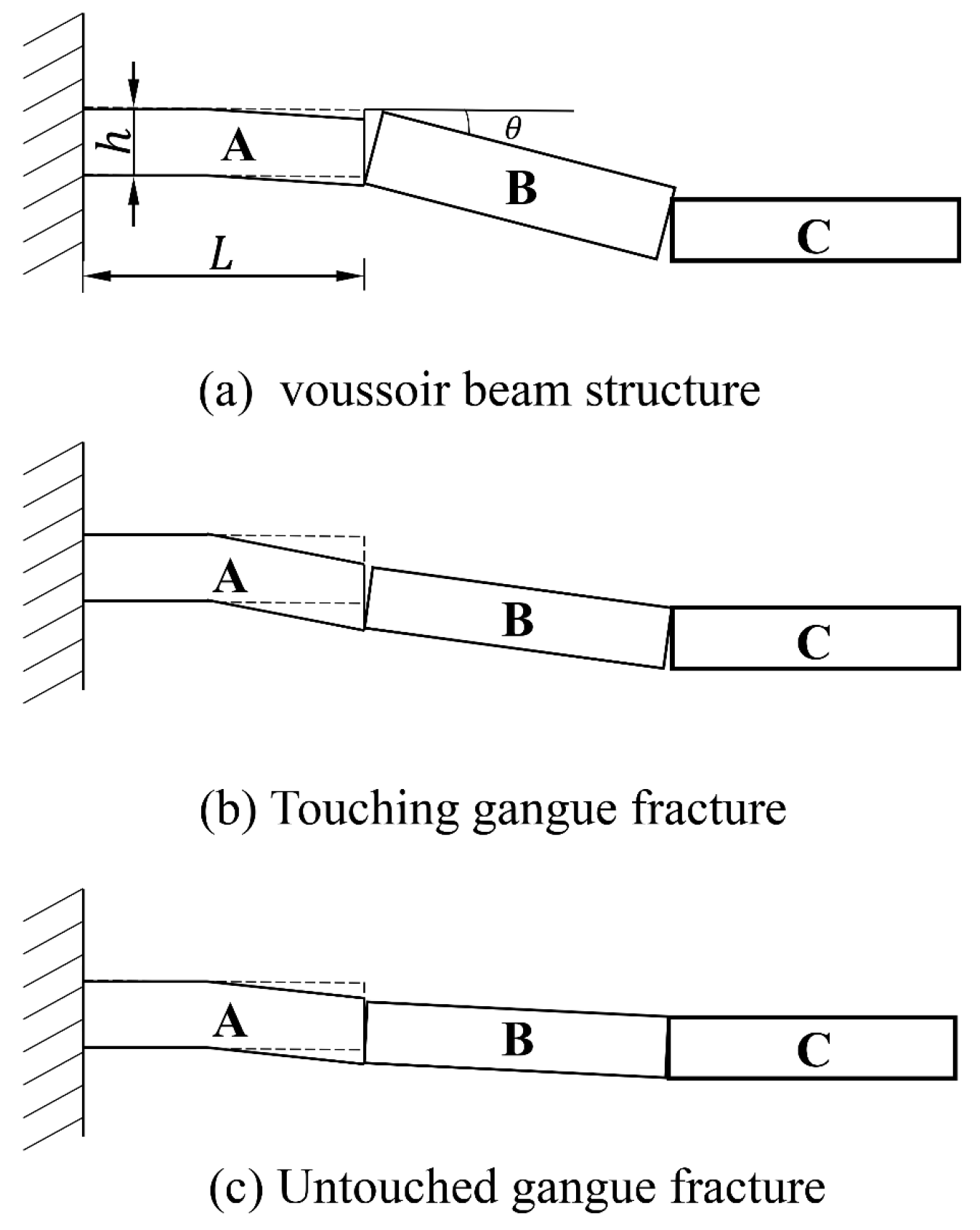
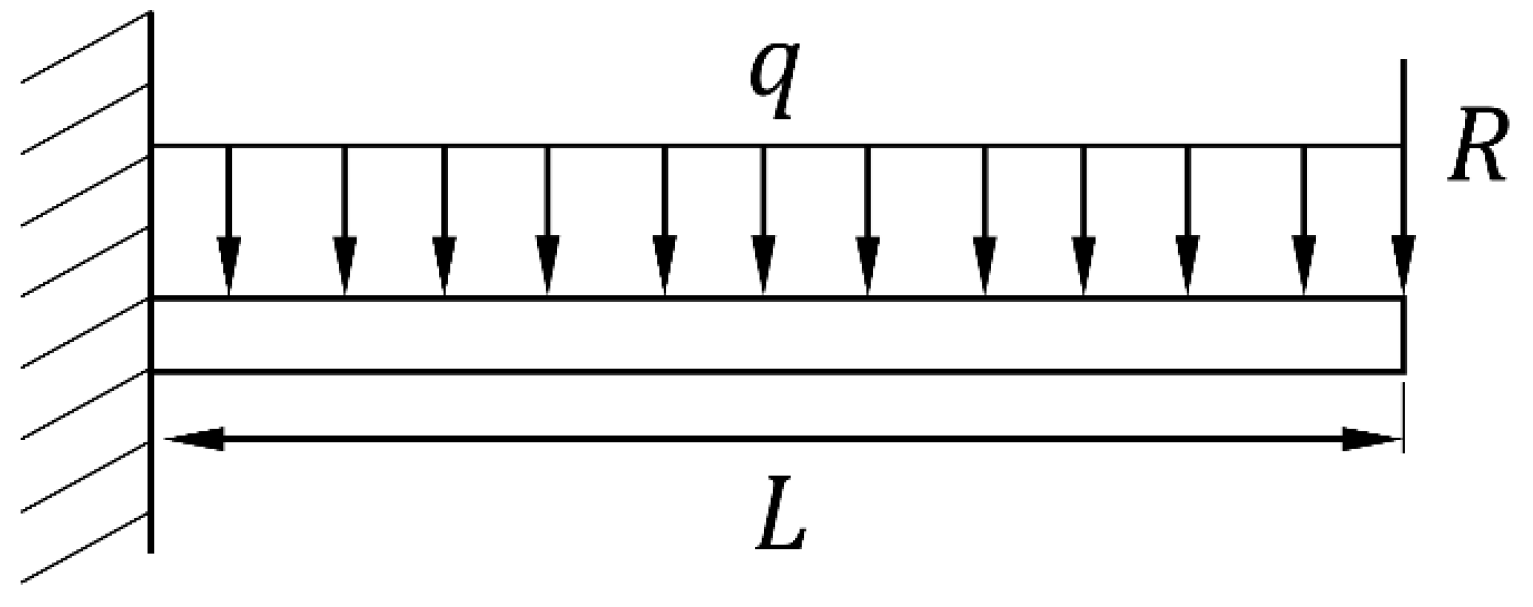


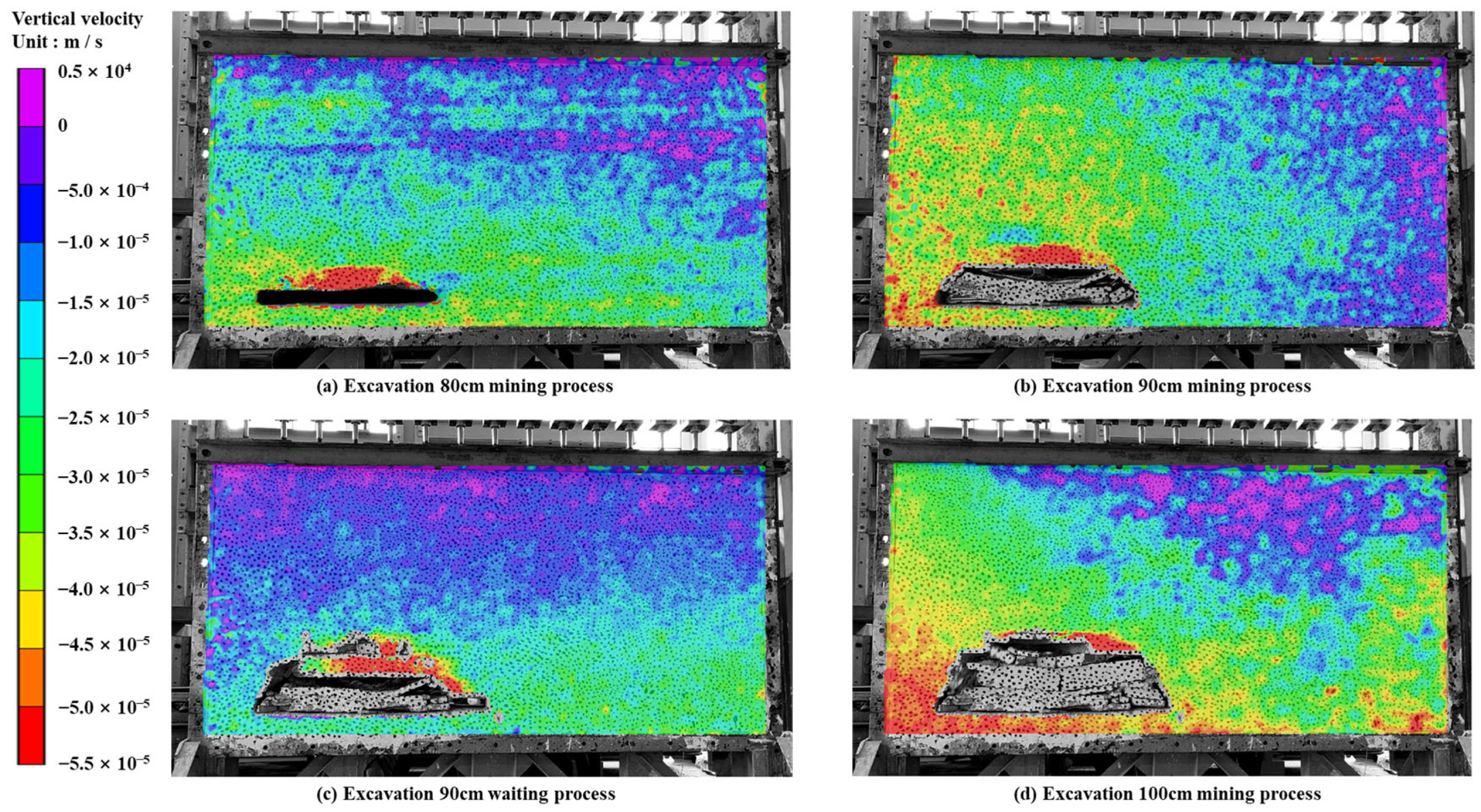
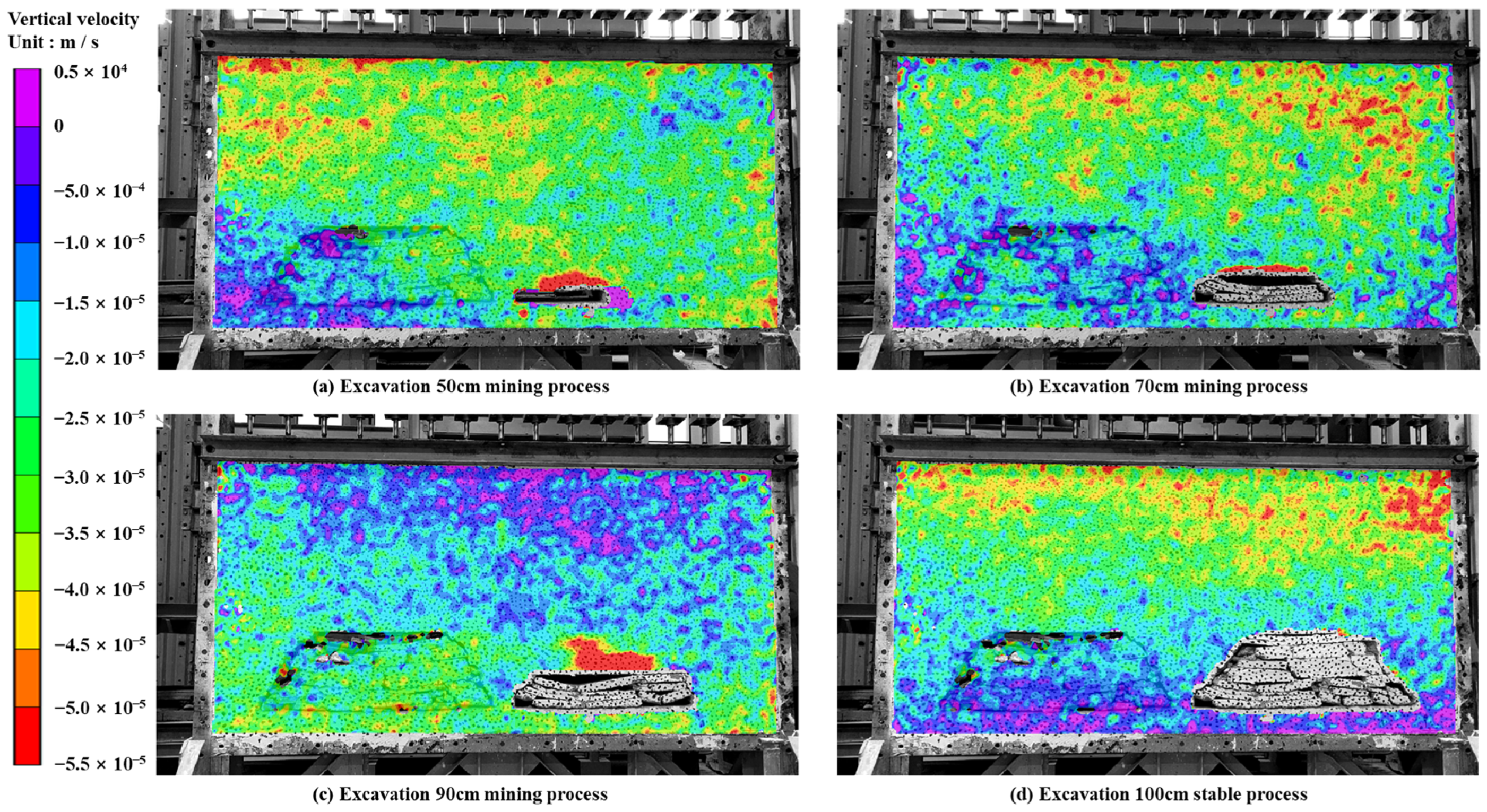
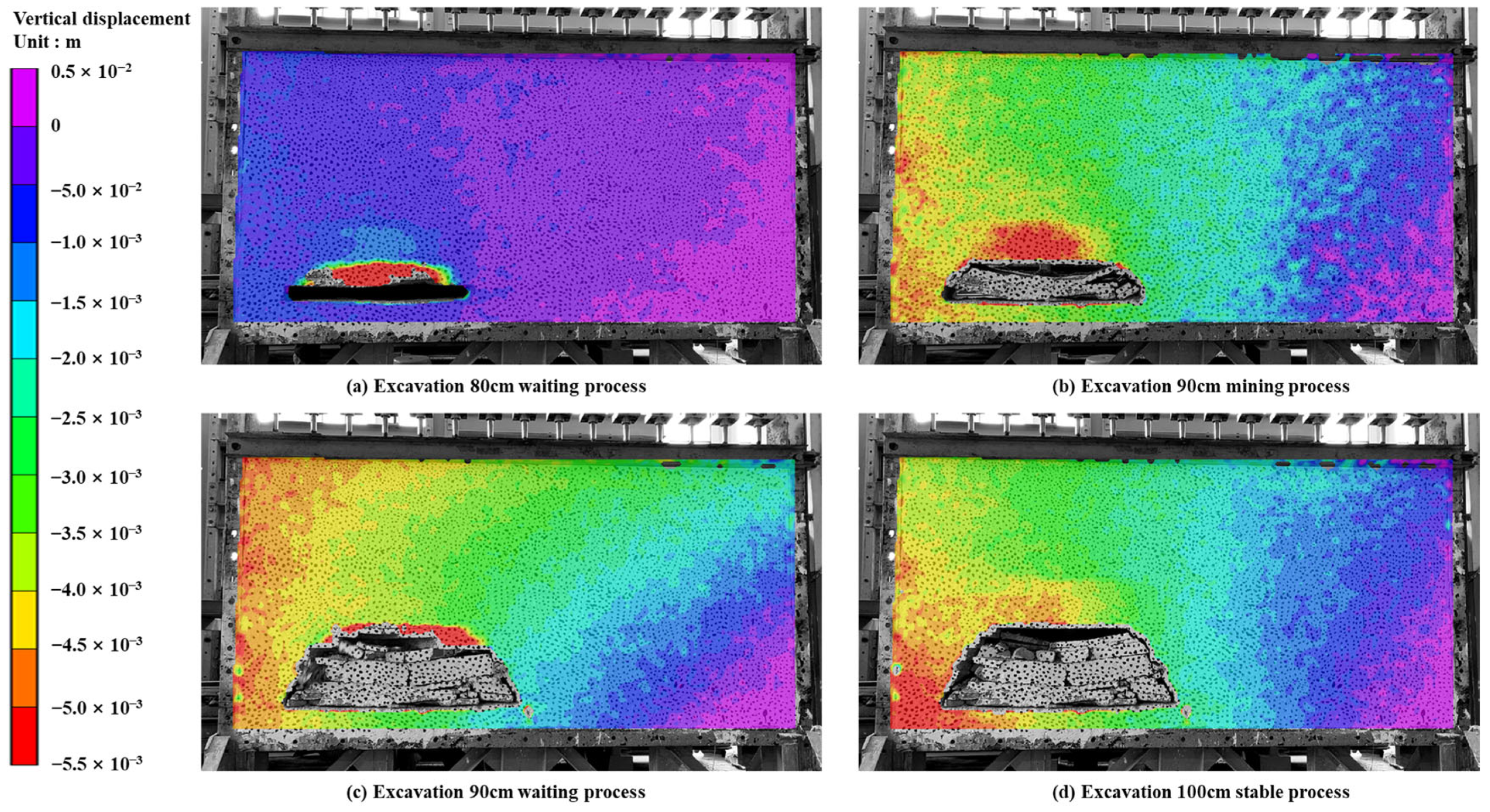


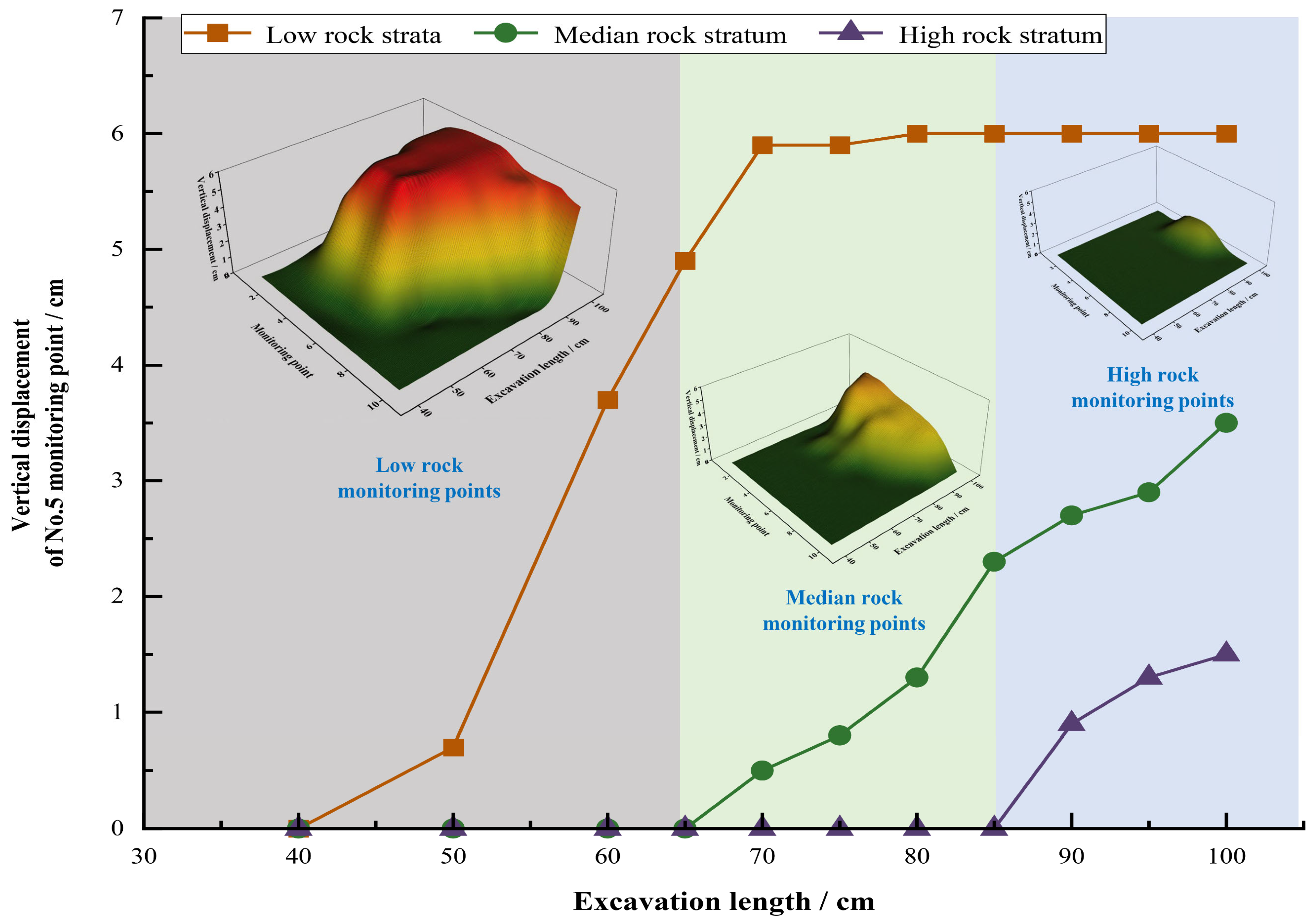



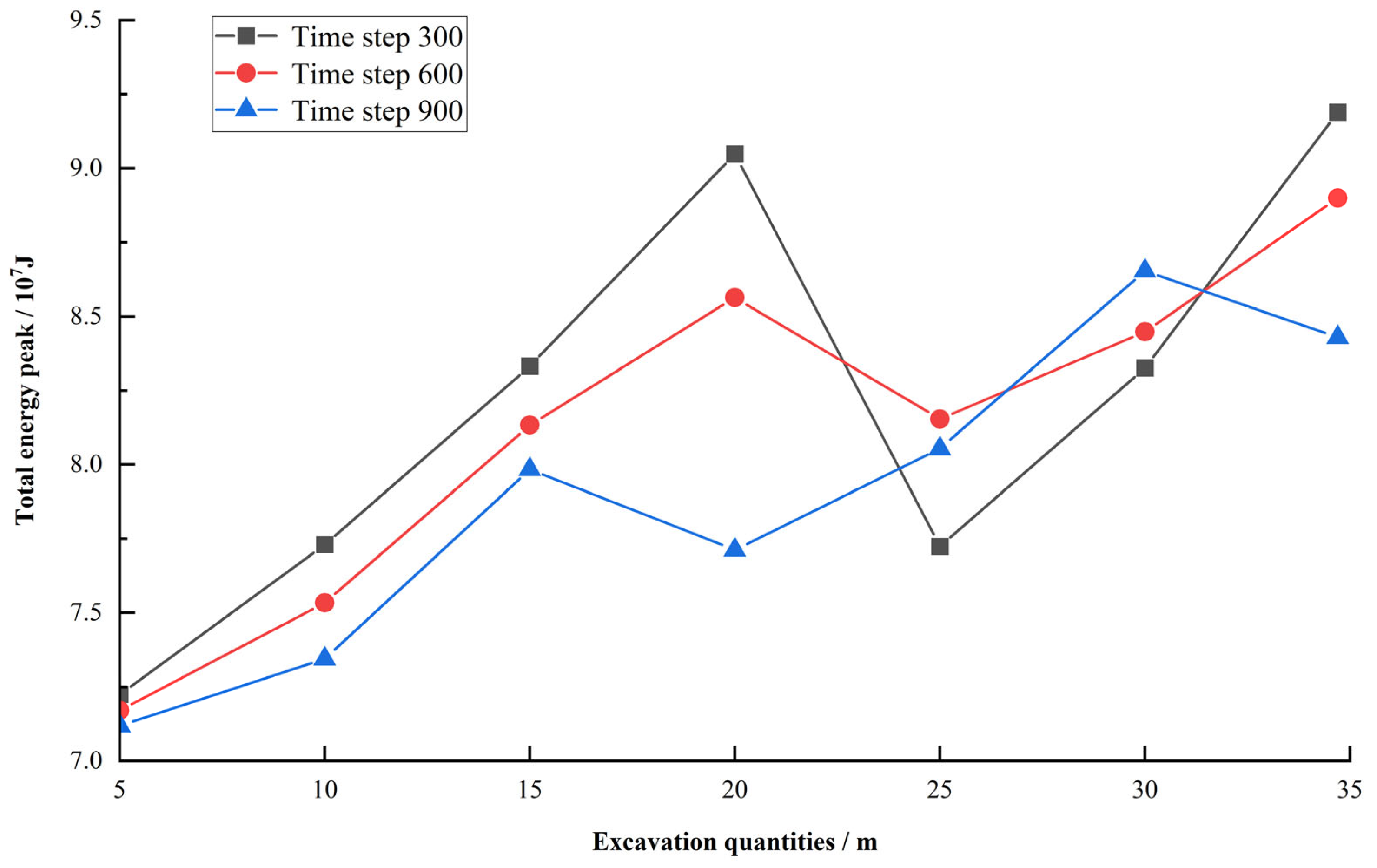



| Level | Rock | Thickness of Stratum/m | Model/mm | Ratio Number (Sand/Calcium Carbonate/Gypsum) | Water Distribution Ratio |
|---|---|---|---|---|---|
| 17 | Water distribution ratio | 5 | 26 | 7:6:4 | 1/9 |
| 16 | Mudstone | 24 | 119 | 7:8:2 | 1/9 |
| 15 | Medium sandstone | 29 | 145 | 6:7:3 | 1/7 |
| 14 | Mudstone | 39 | 196 | 7:8:2 | 1/9 |
| 13 | Water distribution ratio | 34 | 172 | 7:6:4 | 1/9 |
| 12 | Mudstone | 14 | 72 | 7:8:2 | 1/9 |
| 11 | Medium sandstone | 31 | 155 | 6:7:3 | 1/7 |
| 10 | Water distribution ratio | 3 | 15 | 7:6:4 | 1/9 |
| 9 | Mudstone | 3 | 13 | 7:8:2 | 1/9 |
| 8 | Medium sandstone | 10 | 48 | 6:7:3 | 1/7 |
| 7 | Siltstone | 18 | 90 | 8:3:7 | 1/7 |
| 6 | Water distribution ratio | 8 | 40 | 7:6:4 | 1/9 |
| 5 | Mudstone | 2 | 10 | 7:8:2 | 1/9 |
| 4 | Medium sandstone | 4 | 20 | 6:7:3 | 1/7 |
| 3 | Water distribution ratio | 8 | 41 | 7:6:4 | 1/9 |
| 2 | Coal | 6 | 31 | 8:3:7 | 1/9 |
| 1 | Water distribution ratio | 17 | 72 | 7:6:4 | 1/9 |
| Rock | Thickness/m | Volumetric Weight/ g/cm3 | Elastic Modulus/ GPa | Poisson Ratio | Cohesion /MPa | Friction Angle/° | Tensile Strength/MPa |
|---|---|---|---|---|---|---|---|
| Siltstone | 4.2 | 2.36 | 27.02 | 0.19 | 2.9 | 38.65 | 1.44 |
| Fine sandstone | 13.5 | 2.36 | 16.53 | 0.23 | 2.5 | 30.56 | 1.2 |
| Mudstone | 10.71 | 2.42 | 23.16 | 0.2 | 2.85 | 38.88 | 1.41 |
| Medium sandstone | 35.29 | 2.28 | 24.03 | 0.18 | 2.26 | 35.14 | 1.22 |
| Fine sandstone | 3.37 | 2.38 | 19.18 | 0.21 | 2.24 | 35.49 | 1.33 |
| Coal | 6 | 1.33 | 9.52 | 0.21 | 0.99 | 37.41 | 0.5 |
| Fine sandstone | 5 | 2.38 | 19.18 | 0.21 | 2.24 | 35.49 | 1.33 |
Disclaimer/Publisher’s Note: The statements, opinions and data contained in all publications are solely those of the individual author(s) and contributor(s) and not of MDPI and/or the editor(s). MDPI and/or the editor(s) disclaim responsibility for any injury to people or property resulting from any ideas, methods, instructions or products referred to in the content. |
© 2024 by the authors. Licensee MDPI, Basel, Switzerland. This article is an open access article distributed under the terms and conditions of the Creative Commons Attribution (CC BY) license (https://creativecommons.org/licenses/by/4.0/).
Share and Cite
Yu, X.; Gao, M.; Zhao, H.; Zhao, S.; Zhao, H. Research on the Laws of Overlying Rock Fracture and Energy Release under Different Mining Speeds. Appl. Sci. 2024, 14, 3222. https://doi.org/10.3390/app14083222
Yu X, Gao M, Zhao H, Zhao S, Zhao H. Research on the Laws of Overlying Rock Fracture and Energy Release under Different Mining Speeds. Applied Sciences. 2024; 14(8):3222. https://doi.org/10.3390/app14083222
Chicago/Turabian StyleYu, Xin, Mingshi Gao, Hongchao Zhao, Shifan Zhao, and Huashan Zhao. 2024. "Research on the Laws of Overlying Rock Fracture and Energy Release under Different Mining Speeds" Applied Sciences 14, no. 8: 3222. https://doi.org/10.3390/app14083222
APA StyleYu, X., Gao, M., Zhao, H., Zhao, S., & Zhao, H. (2024). Research on the Laws of Overlying Rock Fracture and Energy Release under Different Mining Speeds. Applied Sciences, 14(8), 3222. https://doi.org/10.3390/app14083222








